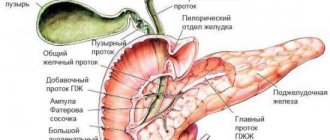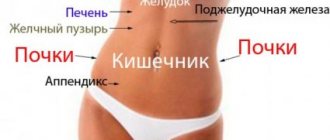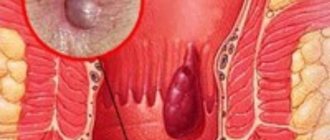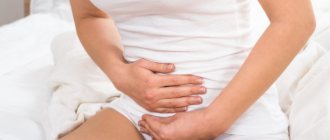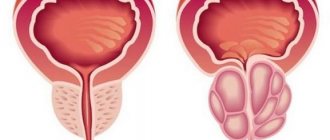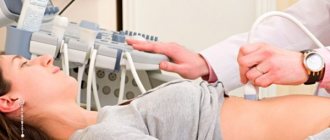Despite the fact that men have abdominal pain much less often than women, these manifestations cannot be ignored.
Pain in the lower abdomen in men is an alarming symptom in many pathologies of the genitourinary system, digestive tract or musculoskeletal system.
Unfortunately, most representatives of the stronger sex tend to ignore unpleasant sensations in the lower parts of the abdominal cavity, thereby contributing to the aggravation of pathological conditions or the transition of ailments to chronic forms.
Causes of pain
In cases where pain is localized in the lower abdomen, a man should suspect diseases such as:
- inflammatory process of the urinary system, in particular the bladder and kidney parenchyma;
- urolithiasis and renal colic provoked by it;
- prostatitis;
- inflammation of the testicles and their appendages;
- appendicitis;
- intestinal diverticulitis;
- hernia formation;
- intestinal obstruction;
- ulceration of the colon, which develops against the background of poor nutrition;
- acute urinary retention;
- benign tumors and malignant neoplasms of the male genitourinary organs.
According to statistical studies, in 60% of clinical cases, the cause of pain in men in the lower abdomen is problems with the genitourinary system, namely prostatitis and cystitis. These illnesses can have very serious consequences, so they should not be ignored.
It is important to remember that pain appears so simply and always accompanies a complex pathological process. Therefore, if pain occurs, a man needs to consult a urologist and surgeon.
What does the location of pain indicate?
This criterion is one of the main diagnostic factors, which allows the specialist to suggest the probable location of the lesion, the cause of the development of the pathological symptom and decide on the choice of further diagnostic and therapeutic tactics.
Anomalies in men in the prostate gland
Abdominal pain in men most often occurs due to the development of pathological processes that affect the prostate gland. There are several types of diseases.
Causes and symptoms of prostatitis
One of the most commonly diagnosed diseases. The prostate gland or prostate is an endocrine organ that is located deep in the pelvic area, just below the urethra.
The main function is the production of secretions during ejaculation. In acute or chronic processes, the pelvic organs are affected, especially the prostate gland.
Why does the lower abdomen hurt in men? A disease such as prostatitis occurs against the background of activation of opportunistic flora. E. coli and staphylococci penetrate the prostate from neighboring organs through the blood.
The cause is not always an infectious process. Adverse factors may be hidden:
- in hypothermia;
- weakened immune function;
- passive lifestyle;
- drinking alcoholic beverages;
- presence of sexual problems.
Men's lower abdomen may hurt. In this case, the unpleasant feeling will have an acute bursting or dull aching character, and will radiate to the perineum area. Due to the fact that the prostate is located next to the bladder and intestinal tract, pain can be localized in the central part of the suprapubic area, external genitalia and anus.
Associated symptoms can also be identified. It consists of:
- in frequent painful urination;
- diarrhea with painful urge to empty the intestinal tract;
- sexual dysfunction;
- raising temperature values.
Chronic prostatitis manifests itself as a result of untreated symptoms and suppression of the immune system. During exacerbation, the symptoms are not as pronounced.
Treatment of discomfort in men is carried out using antibacterial agents, anti-inflammatory drugs, and immunomodulators.
Formation of tumors in the lower abdomen
Chronic prostatitis is one of the causes of prostate cancer. Formations can be either malignant or benign. This process occurs because men ignore the symptoms, do not carry out any treatment and rarely turn to a specialist.
Symptoms of the pathology will appear:
- in pain in the suprapubic area. It can radiate to the sacral area or the penis;
- in frequent urination. Most often, this symptom bothers the patient at night;
- in a weakening stream of urine, a feeling of incomplete emptying of the bladder, urinary incontinence.
Prostate adenoma forms very slowly, but evenly. It does not affect neighboring organs. If the tumor becomes malignant, the cancer cells become aggressive and begin to grow into the intestinal canal, bladder, and lymph nodes.
Benign tumors are treated with drug therapy. This includes taking alpha blockers and rectactase inhibitors. They are needed to relax the muscle structures in the prostate and reduce tissue growth. In some situations, surgical procedures are carried out.
If cancer is diagnosed, the patient undergoes not only surgical procedures, but also chemotherapy.
Signs of illness associated with the representative gland are very similar to each other. Therefore, only an experienced doctor can determine the disease after a thorough diagnosis.
Why does it hurt on the left?
Such pains are, as a rule, a signal of inflammation of internal organs, including the transverse colon and sigmoid colon, genital organs, left kidney and ureter.
On the other hand, such painful sensations can be a manifestation of a hernia, arise as a result of tumor growth, or simply indicate that a man has taken rough food the day before.
Pain in the lower left abdomen is a specific symptom of varicocele, which develops against the background of dilation of the veins of the left spermatic cord.
In this case, only surgical correction of the defect will help save the testicle. Sometimes pain in men on the left side of the abdomen occurs after intense training.
If you experience pain after training, experts recommend stopping physical activity and resting. The pain will either subside or get worse. In the latter option, the patient must be immediately taken to the department of the medical institution or a medical team must be called.
Painful sensations on the right
The main cause of pain, which is localized in the right lower abdomen, is problems with the intestines.
According to statistical data, this symptom comes to the fore in almost all men admitted to the hospital with inflammation of the appendix of the ascending colon and lower ileum, as well as the cecum.
Also, pain in the right abdomen accompanies kidney disease on the affected side, tumors and ailments of the internal genital organs.
Abdominal pain on the right is a common symptom of surgical pathology. Therefore, you should not tolerate them, but immediately seek qualified medical help.
What should you suspect?
Pulling, cutting, sometimes quite intense pain in the lower abdomen in men, which is accompanied by urinary retention and erectile dysfunction, and also spreads to the groin, scrotum and inner thigh area, most likely indicates the development of prostatitis.
An inflammatory process in the prostate gland occurs in every second patient after the age of 50, which is associated with the structural features of the male genital area.
Healthy prostate (left) and prostatitis (right)
Left without medical attention, acute prostatitis very quickly transforms into a chronic form of the disease.
An inflammatory process with a chronic course, despite its lethargy and relative secrecy of pathological symptoms, leads to the proliferation of gland tissue and the formation of adenoma - a benign prostate tumor. The adenoma increases in size over time, puts pressure on nearby organs, causes male impotence and serious problems with urination.
Prostatitis in men is one of the most common diseases leading to infertility and cancerous degeneration of the prostate gland.
What can cause the pain syndrome?
Pain in the lower abdomen can be caused by various pathologies of internal organs. Disturbances in the functioning of the liver, kidneys, and intestines are accompanied not only by severe pain, but also by digestive disorders (diarrhea, constipation), impaired urination, elevated body temperature, chills, and fever. This could be an intestinal ulcer, appendicitis, renal failure, cholecystitis, pyelonephritis, etc.
Typically male diseases develop in the area of the internal and external genital organs. Their symptoms may resemble signs of diseases of the abdominal organs. But inflammatory processes occur in the “male” zone (internal and external genital organs). The internal ones include: prostate gland, bladder, seminal vesicles, cavernous bodies. To the external – testicles, penis, exit of the urethra.
Rapidly progressing male pathologies can lead to various complications, and then it is necessary to treat both the underlying disease and the accompanying one. Such “secondary” diseases include urethritis, cystitis, impotence, and infertility.
Prostate adenoma
Prostate adenoma is a male disease in which benign enlargement of the prostate gland occurs, causing narrowing of the urethra and associated urinary disorders. These processes cause congestion in the kidneys and bladder. Symptoms increase gradually. Pain in the lower abdomen and groin area in a man is a typical sign signaling an inflammatory process, which in some cases leads to acute urinary retention.
The disease can be caused by:
- Infectious diseases affecting the genital area.
- Sedentary lifestyle.
- Work involving prolonged static body position (drivers, office workers).
- Age-related changes in the body.
- Hypothermia.
- Having bad habits
- Intestinal disorders (diarrhea, constipation).
People who lead a healthy lifestyle have a much better chance of avoiding the development of this pathology.
As the disease develops, pain of varying intensity in the lower abdomen is felt in a man along with other signs that characterize a certain stage of the disease:
- Stage 1. The bladder still empties completely, but at night the urge to go to the toilet occurs much more often. In order to feel relief, the patient has to contract the abdominal muscles. The urine stream is weak, urination takes a long time. There is a feeling that the bladder is not completely emptied.
- Stage 2. The mucous membrane of the bladder swells, urination occurs only due to the efforts of the abdominal muscles. Urine may be released in small portions intermittently. The upper urinary tract may become compressed, which interferes with the flow of urine and can cause sharp, stabbing pain in the pubic area when the muscles are tense. The bladder is not completely emptied; after each urination, up to 100 ml of urine can remain in it. The functioning of the kidneys is disrupted, which provokes a feeling of constant thirst. A bitter taste appears in the mouth.
- Stage 3. The bladder cannot be emptied even with repeated muscular effort. Urine is released spontaneously in small volumes (20-30 ml). The urge to go to the toilet occurs constantly. Since urine is not excreted, the process of intoxication of the body begins, which is expressed through severe nausea and headaches. A distended bladder can be easily felt through the walls of the abdomen.
Prostate adenoma is dangerous because it can lead to acute urinary retention, in which in some cases the only way to save the patient is urgent surgery.
Pain in the lower abdomen (above and below the pubis) in a man requires an immediate and thorough examination of the body, including:
- Cystoscopy.
- Rectal digital examination.
- X-ray (urography).
- Ultrasound (ultrasound examination), etc.
If the disease is mild, pain of a different nature (aching, sharp) in the lower abdomen in a man is treated conservatively, aimed at restoring the patency of the urinary outlet. In each individual case, drugs are prescribed individually by the attending physician. These may be medications that facilitate the process of urination: Alfuzosin, Finasteride, Kamiren, etc. Products whose main components are medicinal herbs also have a good effect: African plum bark extract (Trianol), creeping palm fruit extract (Prostoplant).
Classification of the main types of pain in men in the lower abdomen
Based on the nature of the pain, one can judge the type of disease, the reason for its development, or the course of the disease:
- sharp and sudden pain in the lower abdomen indicates an acute pathological process, for example, intestinal obstruction, blockage of the urinary tract, peritonitis;
- mild pain that develops gradually is characteristic of indolent diseases of the pelvic organs and lower abdominal cavity;
- throbbing and rhythmic pain is a sign of increased pressure in the hollow organs;
- painful sensations of moderate intensity, which are constant, accompany inflammatory processes in the organs of the lower abdomen.
How to confirm the diagnosis?
As a rule, several specialists work to make a diagnosis in a patient with pain in the lower abdomen, including a urologist, a surgeon and a gastroenterologist.
During the examination, they consistently establish the cause of the pain syndrome, based on:
- the patient’s complaints and his subjective feelings about the nature of the pain;
- medical history;
- data from an objective examination carried out by palpation of the abdomen, palpation of the prostate gland, etc.;
- results of laboratory and instrumental research methods, in particular urine and blood analysis, ultrasound diagnostics, radiography, CT and MRI, as well as, if necessary, biopsy of tumors.
When is it necessary to seek medical help immediately?
Men can often experience pain in the lower abdomen, which is a signal that a person is developing an urgent pathological condition. In such cases, the patient needs to call a medical team.
Acute and unbearable pain in the lower abdomen usually accompanies surgical diseases, in particular acute appendicitis, diverticulitis, strangulated hernia, and intestinal obstruction.
With appendicitis, pain is associated with inflammation of the appendix of the colon and occurs predominantly in the right parts of the abdominal cavity with irradiation to the right leg, scrotum, and gluteal area. The pain syndrome is accompanied by an increase in general body temperature, the development of symptoms of intoxication, nausea and occasional vomiting.
If you suspect appendicitis, you should immediately call an ambulance and under no circumstances take painkillers, as they will not reveal the clinical picture of the underlying disease and will complicate its diagnosis.
A pinched hernia and acute intestinal obstruction also require immediate response. Left without medical attention, these diseases lead to an increase in symptoms of local inflammation of the peritoneum, soft tissue necrosis, septic shock, and therefore, if surgical treatment is not provided in a timely manner, they can be fatal.
Reproductive diseases in men
If a man’s lower abdomen hurts, the reasons may be hidden in diseases of the reproductive type. There are several common pathologies.
Vesiculitis - signs and symptoms
The seminal vesicles are a small organ located on the side of the prostate. Their main purpose is to produce sperm and maintain sperm activity.
When the seminal vesicles become inflamed, a disease called vesiculitis occurs. The causes of the pathological process are infectious agents that penetrate from neighboring organs: prostate, bladder, testicles.
The main symptom is severe pain in the abdominal area. In this case, unpleasant sensations can be felt both on the left and on the right. Increased discomfort is observed during ejaculation, before urination or bowel movement.
There are other signs of anomaly. They appear as follows:
- discharge from the urethra of a cloudy, grayish-white color mixed with blood;
- frequent urge to empty the intestinal canal and bladder;
- raising temperature values.
If the lower abdomen hurts in men for this reason, then treatment measures include following a strict diet, taking antibacterial and anti-inflammatory drugs, using physiotherapeutic procedures and vitamins. When an abscess forms in the seminal vesicles, surgical intervention is performed.
Orchitis in men
Why do men have stomach pain? The cause of this unpleasant phenomenon can be a disease such as orchitis. It leads to inflammation in the testicles. Unfavorable factors may include prostatitis, urethritis, vesiculitis, mumps, mumps, and gonorrhea. The pain can radiate to both the right and left testicle. At the same time, apply to the groin, sacral and lumbar areas.
In addition to all this, there are other symptoms that appear:
- in the enlargement of the inflamed organ;
- general malaise, weakness, deterioration of general health, lethargy;
- raising temperature values;
- nausea, headaches.
When a man has abdominal pain due to orchitis, treatment is based on diet, taking antibacterial or viral agents, and the use of antispasmodic and restorative medications. The most common complication is infertility, so the disease should not be neglected.
Modern approaches to treatment
Conservative treatment is indicated for patients in whom, during research, the diagnosis of prostatitis, inflammatory or spastic process in the intestines, inflammation of the bladder, etc. was confirmed.
Naturally, each of the listed diseases requires its own set of medications, the advisability of prescribing each of which falls on the shoulders of the attending physician.
Surgical elimination of pain, which is localized in the lower abdomen, is indicated for acute appendicitis, peritonitis, tumors, intestinal obstruction, etc. In most cases, it is performed immediately, immediately after confirmation of the surgical diagnosis.
Any pain in the lower abdomen should not be ignored by the patient, as it indicates the emergence of a complex pathological process.
Video on the topic
A neurologist talks about how to distinguish chronic pelvic pain (pain in the pelvic area) from typical diseases in men:
https://youtube.com/watch?v=bVs6YSzebi4
Pain in the lower abdomen in men is a very multifactorial symptom. The fact is that organs of completely different systems are projected into this zone, called the hypogastrium in anatomy: digestion, urination, and reproductive systems. A malfunction of any of them leads to pain in the area of interest to us.
Since the problem falls within the competence of different specialists, the man is offered consultations with a gastroenterologist and urologist-andrologist. To identify the cause of such pain, doctors must carefully question the patient and identify additional symptoms. It indicates damage to a specific organ.
You cannot do without laboratory and hardware examination. Impatient men should carry out the diagnosis to the final result. Only after this can we hope that the chosen path for treating pain will be reliable and optimal.
Measures to eliminate the disease
If pain in the lower abdomen in men is sharp, acute, and painkillers do not help, then in such cases you should call an ambulance.
If the pain is with spasms, this can be relieved with antispasmodics or analgesics, but still do not delay a visit to the doctor, who will either prescribe treatment or refer you for the necessary tests.
Do not forget that if you contact them in the early stages of the development of diseases, they are completely treatable, while delaying examination and treatment leads to either the disease developing into a chronic form or more severe consequences.
Anatomical structures in the lower abdomen and their functional significance
Let us briefly consider what organs lie in the lower abdomen and what they “do.” This will make it possible to identify the specificity of additional signs of damage. In the center above the pubis is the bladder, the lower part of the ureters, and the loops of the small intestine joining it.
The bladder serves as a reservoir for urine. It can stretch up to 500 ml. The ureters are attached to it on both sides, bringing urine produced by the kidneys. In the lower narrow part there is a muscle - the detrusor. The state of delay during spasm or incontinence during atony depends on its operation.
The urethral canal, unlike the female one, is longer and narrower. The process of urination is a complex reflex mechanism. The loops of the small intestine are part of the digestive system. They are covered from the inside with thin villous protrusions, which significantly increase the area of contact with the contents.
To the right and left of the suprapubic zone are the iliac regions. Here, abdominal pain can be caused by:
- in right-sided localization - diseases of the cecum, appendix, ureter, small intestine;
- with left-sided - pathology of the small, sigmoid and rectum, ureter.
The large intestine takes up the remaining fluid and forms feces, and is responsible for excretion through peristaltic movements and defecation. The sigmoid and rectum are extreme in this process.
The appendix is an appendage of the cecum. There was a time when it was considered a completely unnecessary education. But it has now been proven that the vermiform appendix is involved in:
- production of immunoglobulins and antibodies;
- controls the antigenic properties of food composition and signals to the centers of the brain;
- takes an active part in the formation of a rejection reaction against the background of incompatible transplantation;
- helps beneficial bacteria and fights rotting microorganisms;
- under the age of 16 produces lymphocytes as iron;
- participates in digestion, digesting fiber, decomposing starch (for this it is called the “second salivary and pancreas”);
- produces a secretion that enhances intestinal motility, therefore preventing constipation.
Pain in the lower abdomen is an understandable symptom of damage to the lumbosacral spine. Disruption of the structure of the vertebrae, compression and irritation of the nerve roots lead to irradiation to the lower part of the lower back, abdomen, and thighs.
In such cases, the nature of the sensations becomes “shooting”, and zones of numbness of the skin appear. These structures can cause pain in the lower abdomen in both men and women.
What specific male organs are the culprits of pain?
The cause of pain in the lower abdomen in men can be diseases of the genital organs (prostate and seminal vesicles). They are located in the pelvic cavity, and not in the abdomen. But there is severe pain below the navel.
The prostate or prostate gland lies inferior to the bladder and anterior to the rectum, surrounding the urethra. Produces seminal fluid. During an erection, it blocks the flow of urine and throws secretions into the urethra. The activity is closely related to the function of the endocrine system (including the testes, adrenal glands).
The seminal vesicles are located above the prostate gland in the middle. This is a paired organ that produces secretions to support sperm viability. Older patients experience difficulty urinating and inflammation caused by stagnation. Violation of secretion production in the seminal vesicles of a young healthy guy makes him childless.
To find out why the lower abdomen hurts in men, it is necessary to examine all internal and external genital organs: testicles, seminal vesicles, prostate, urethral glands, vas deferens, scrotum and penis. Pain in the lower abdomen has its own characteristics. We will consider their diagnostic value for the most common diseases.
The appearance of pain or severe discomfort in the lower abdominal region in a man is an indicator of the development of a disease or inflammatory process. Pain is just a symptom that indicates the presence of pathology, but is never an independent disease.
Therefore, when the first symptoms appear, you need to determine the cause and seek medical help. Timely differential diagnosis and correctly prescribed therapy are the key to quality treatment and preservation of health.
Diseases that cause pain
Pathological processes that provoke pain in the right lower abdomen in men can relate to any disorder associated with the condition of the internal organs. The most likely diseases are:
- abnormalities in liver function. Hepatitis, characterized by inflammation of gland tissue, is often a dangerous cause of pain . The anomaly is accompanied by problems with digestion, increased body temperature, and increased discomfort during movement. In the final stages of the disease, gastrointestinal bleeding may occur;
- gallbladder pathology. Gallstone disease and inflammation of the organ can cause acute pain, localized in the upper right part of the abdomen. This is caused by spasms of smooth muscles. The intensity of pain in this case is very high.
- appendicitis. The most common circumstance that causes pain in the lower abdomen on the right side in men. In the case of an atypical location of the appendix, the patient may experience discomfort in other parts of the body: in the subcostal area, lower back and pubic area. The first symptom indicating inflammation of the appendage of the cecum is vomiting;
- pancreatitis. Pancreatic disease is characterized by acute pain in the epigastric region. It can spread under the ribs and radiate to the lower back or back. Nausea and vomiting complement the symptoms;
- diseases of the small and large intestine. Ailments include: diverticulitis, intestinal obstruction, hemorrhoids, colitis, Crohn's disease. Each of the pathologies is accompanied by symptoms characteristic of the disease, but pain in the right lower abdomen is observed in all of the presented anomalies;
- dysfunctions of the urinary system. Often, pain indicates the occurrence of cystitis, nephrolithiasis, pyelonephritis and other pathologies of the bladder, kidneys, ureters and urethra. Those susceptible to inflammation may experience colic in the kidneys, pain in the lower abdomen and groin. A man may also feel a frequent urge to urinate, burning and itching. Cloudiness of urine is one of the typical signs of an abnormal process developing in the urinary organs;
- diseases of the gastrointestinal tract and duodenum. Gastritis, ulcers, stenosis can cause pain;
- damage to the spine and spinal cord. The catalysts for pain are often tuberculosis, bone tumors, damage to the lining of the brain, meningomyelitis and spinal column injuries.
On our website: Why does the lower abdomen hurt during ovulation?
Infectious diseases are often attributed to the causes of pain that is localized on the right side.
The main reasons why pain in the lower abdomen in men
The most common causes of pain in the lower abdomen in men are dysbiosis, bloating, constipation, and physical damage. Pain can also appear with the development of one or more pathologies and can be localized in different parts of the abdomen.
Pain in the left lobe
There are many reasons why severe pain in the left side may occur, but a number of main ones stand out:
- gastritis or gastroduodenitis;
- acute enlargement of the spleen;
- splenic infarction;
- spleen abscess;
- volvulus of the spleen;
- chronic myelo- and lymphocytic leukemia;
- Crohn's disease;
- polyposis;
- atypical location of the inflamed appendix;
- diverticulitis;
- sigmoiditis;
- diverticulosis of the sigmoid colon;
- irritable bowel syndrome;
- sigmoid colon cancer;
- urolithiasis disease;
- intestinal obstruction.
Pain in the right lobe
In most cases, pain on the lower right side of the abdomen indicates appendicitis, but a number of problems are also possible, such as:
- inflammation of the right kidney or ureter;
- appendicitis;
- Crohn's disease;
- nonspecific ulcerative colitis, in the progression stage;
- diverticulitis;
- diseases of the spine;
- ileitis.
Pain in the groin area
Pain in the lower abdomen, radiating to the groin area in men, most often occurs in the presence of the following diseases:
- acute prostatitis and exacerbation of chronic prostatitis;
- cystitis;
- bladder cancer;
- prostate cancer;
- hemorrhoids
- hernia
- vesiculitis.
Chronic pelvic pain syndrome is an unpleasant and quite common condition in men, when a feeling of heaviness, discomfort, and fullness is present in the lower abdomen and affects all areas of a man’s life: his potency, ability to enjoy life and express positivity in the value system.
Diagnosis based on the nature of the pain syndrome
| Blunt pain |
|
| Acute pain |
|
| Cramping pain |
|
| Sharp pain |
|
| It's a dull pain |
|
| Nagging pain in the lower abdomen |
|
| Cutting pain |
|
| Severe pain |
|
Symptoms of diseases of the lower abdomen
To find out which doctor to contact for medical help, it is necessary to determine all tangible deviations in the body’s functioning and the presence of discomfort in the area where the organs are located.
As a result of such anamnesis collection, 90% of the causes of this symptom can be determined. But such diagnostics are prohibited in case of acute and prolonged pain, and you should immediately call an ambulance or go to the surgical department of the Central District Hospital.
In order to conduct a quick self-diagnosis, you just need to compare the pain and symptoms with the following diseases:
- Constipation and bloating . In most cases, constipation and bloating occur when the upper intestines are disrupted or when heavy and poorly digestible foods are consumed. Colic and spasms appear, which occur when the walls expand with gases and feces.
- Dysbacteriosis . It develops as an independent disease or as a result of taking antibiotics. Fungi, pathogenic and conditionally pathogenic microorganisms irritate the intestinal walls, thereby causing colic and discomfort in the lower abdomen in men. Depending on the type of microorganism and health status, symptoms increase over several days.
- Worm infestation . Painful sensations appear after irritation of the mucous membrane by worms. Depending on the type of parasite, the pain can be bursting, acute, short-term or long-lasting with spread throughout the intestine.
- Damage . The causes of pain can be injuries and acute pathologies of internal organs, subsequently developing violations of the integrity of their structures. As a result, acute, prolonged pain or periodic attacks appear with increasing intensity and strength of sensations.
- Peritonitis . Subsequently, a violation of the integrity of the structures of hollow internal organs and the outpouring of foreign contents into the abdominal cavity develop. The disease begins acutely with an increase in symptoms. Depending on the location of the damage and the nature of the contents, the first signs can appear anywhere in the intestine and spread quickly.
- Neuritis of the sciatic nerve . It is characterized by the development of an inflammatory process of the sciatic nerve as a result of intervertebral compression or traumatic damage to the structure of the nerve fibers. Depending on the location and degree of damage, pain spreads to different innervated areas - the thigh, right or left iliac region and lower abdomen.
- Spinal injuries . Spinal injuries lead to pinching of the roots of peripheral nerve fibers and inflammation with pain and tunnel syndrome, paresis or paralysis of the innervated surface. Injuries to the lumbar spine often lead to pain in the right or left iliac region radiating to the leg.
- Abdominal injuries . Subsequently, traumatic effects lead to the formation of bruises of organs, violations of their integrity and hematomas. As a result, pain of a different nature appears depending on the degree and location of the damage.
- Diseases of the urinary system . It is characterized by inflammatory processes of the urinary system, subsequently exposed to bacteria or fungi. It manifests itself as colic in the kidneys and lower back, radiating to the bladder and down the abdomen. Inflammation of the bladder is manifested by pain in the lower abdomen, which intensifies when it is 10% full and during urination.
- Vesiculitis, testicular torsion and orchitis . They manifest as pain in the groin area with irradiation to the lower extremities, pelvic organs and down the abdomen. Sometimes the sensations become unbearable and require the administration of painkillers. Irradiation to the sacrum often occurs during urination or defecation. With orchitis and testicular torsion, swelling of the scrotum occurs with constant pain.
- Acute intestinal obstruction . It develops as a result of intestinal blockage with feces, foreign bodies and adhesive septa. The intestinal lumen is blocked and its functioning stops.
- Neoplasms and oncology . Under the influence of environmental factors or genetic predisposition, tumors appear in the pelvic cavity. Depending on the characteristics of their structure, location and degree of damage to internal organs, they cause pain and discomfort.
- Appendicitis . The cause of pain is an inflamed appendix. The disease develops acutely or gradually, with an increase in symptoms subsequently of circulatory disorders, damage to the mucous membrane by a bacterial infection or blockage of the lumen of the appendix. Depending on the characteristics of a man’s body, pain at the beginning of the inflammatory process can appear in any part of the abdominal cavity. Gradually, acute pain concentrates in the right iliac region.
- Prostatitis . Inflammation of the prostate gland, which occurs in men over 35 years of age, due to impaired blood circulation and an increase in the size of the prostate. Such inflammations are caused by a bacterial infection that enters the gland through the blood and the ascending tract of the urinary system. Initially, discomfort is felt when urinating, which gradually turns into cutting sharp pain in the lower part of the abdominal cavity. A distinctive symptom is an increase in temperature, pain in the rectum during bowel movements, and false urges with an empty bladder. If the disease is not treated, after some time problems with urination and acute urinary retention appear.
- Haemorrhoids . Subsequently, the dilation of the vessels of the rectum forms nodes. After some time, they become inflamed and cause discomfort in the anus with pain radiating to the suprapubic region. A distinctive symptom is the appearance of blood streaks on the surface of the stool and increasing discomfort in the anus.
- Hernia . As a result of lifting weights, a bulge may appear in the right or left iliac region, which becomes more painful every minute. Unpleasant sensations intensify and spread as the intestinal loops are pinched. In case of such phenomena, you should immediately seek medical help.
Lower abdominal pain in men: Causes and symptoms
This condition can occur as a result of problems such as:
- inflammation of appendicitis;
- unbalanced or poor diet, which is the reason for the development of peptic ulcer;
- cystitis;
- diverticulitis;
- hypothermia of the body;
- pyelonephritis;
- herniation;
- varicoceles;
- stones in the kidneys;
- prostate adenoma;
- prostatitis.
In most cases , pain in the lower abdomen begins in men as a result of problems or diseases of the urinary system. The most common factors that provoke these sensations are prostatitis and cystitis (about 60% of cases). If cystitis develops, aching pain in the lower abdomen begins to appear, which can be combined with frequent urge to go to the toilet, and in some cases an increase in temperature occurs. If treatment is not carried out in a timely manner and the causes are eliminated, the acute stage of cystitis becomes chronic. This cystitis will appear when the immune system is weakened, stress, or hypothermia.
Also, the cause of discomfort and pain may be poor intestinal permeability. Because of this, pain appears in the lower abdomen on the left; in men it is dull in nature. This phenomenon is accompanied by prolonged constipation with frequent urge to go to the toilet, as well as spasms in the intestines. Dizziness, general weakness, and nausea may occur. If measures are not taken to eliminate this condition, vomiting of feces begins, and the body temperature reaches critical levels.
Another reason for feelings of severe discomfort is a disease such as vesiculitis; if timely treatment is not carried out, this disease leads to infertility. Painful sensations can be caused by inflammation in the testicles or urinary retention. In some cases, pain occurs as a result of the development of a tumor of the genital organs.
Causes of pain in the left lower abdomen
The manifestation of pain requires careful examination . It is necessary to pay attention in which part of the abdomen these unpleasant sensations begin to appear - in the left or right. Sudden pain in the left lower abdomen is evidence of many health problems, these are possible:
- inflammatory processes of the transverse colon;
- inflammation processes in the genital organs;
- pathological or inflammatory processes in the kidney on the left;
- inflammation of the sigmoid colon;
- Pain or discomfort can be caused by hernias, cysts, inflammation in the testicles, lesions in the pancreas or pathological processes, consumption of rough food that is difficult for the stomach to digest.
A nagging pain in the lower abdomen on the left side sometimes indicates the appearance of a disease such as varicocele (enlargement of the seminal veins).
When pain occurs during sports training or physical activity, shaking of internal organs can be considered as the cause of this phenomenon. You need to take a break and the pain will disappear on its own.
Causes of pain in the lower abdomen on the right
These sensations are associated with inflammation of the appendix , inflammation processes in the internal genital organs, the lower part of the ileum, the cecum, and the ascending colon. This may also indicate inflammation or pathological processes in the right kidney, and it is not necessary that the pain radiate to the lower back.
The main cause of abdominal pain on the right side is diseases of the intestinal tract. This also often indicates appendicitis. During this process, pain appears in the navel area, then moves to the entire lower abdomen. This condition may be accompanied by vomiting or nausea, increased body temperature, general weakness, and diarrhea.
Causes of nagging pain in the lower abdomen
Nagging pain in the lower abdomen may indicate the development of a disease such as prostatitis. Moreover, a sharp stabbing pain may occur, which spreads to the entire groin area, testicles and perineum. At the same time, pains appear in the abdominal area due to erectile dysfunction, urinary retention, or during urination itself.
If there is a sharp pain in the lower abdomen during urination or defecation, which radiates to the anus and sacrum, then the acute stage of prostatitis can be considered. If the disease is not cured in a timely manner, it will become chronic, and then into prostate adenoma. If this happens, the pain becomes pressing and dull, and potency is completely impaired.
Prostatitis is characterized by sensations of pain in the scrotum and perineum , which radiate to the groin area. If the infection progresses, the pain moves to the lower back and lower abdomen; in some cases, pain of an unclear and vague nature may appear, therefore it is very difficult to determine its localization. If the initial symptoms are ignored and if prostatitis is not treated, the pain will intensify, pain will spread to the testicles and groin, and urination will also be delayed. Against the background of these processes, the sexual function of a man or even a young guy worsens.
the disease develops into prostate adenoma. Moreover, an increase in the size of the prostate provokes compression of the urinary tract, which is accompanied by aching pain. General health worsens, frequent urges to urinate occur, but they are ineffective (the so-called false urges).
If chronic prostatitis begins , the pain is not pronounced; it manifests itself after overwork, alcohol abuse, or hypothermia. Sometimes a nagging, unpleasant sensation of pain is felt in the pubic or perineal area. Reasons for the appearance of prostatitis of the prostate gland (both chronic and acute):
- pathologies in sexual processes;
- hormonal disorders or imbalance in metabolic processes;
- infectious processes;
- poor physical activity (for example, working at a computer);
- excessive consumption of alcoholic beverages.
Moreover, if nausea appears and blood pressure decreases, chronic or acute pain becomes severe, then this requires urgent medical attention.
Pain with inguinal hernia in men
An inguinal hernia is a protrusion of the greater omentum, part of the intestine or other pelvic organs through the inguinal opening. This condition can occur as a result of chronic coughing, lifting a heavy object, or physical activity. Since the male inguinal canal is not very well secured by muscles and tendons, men encounter this problem more often than women. The development of a hernia is accompanied by aching pain that intensifies when walking. If it gets pinched, a sharp spasm is felt in the groin. It may also be accompanied by stool retention and vomiting. The disease can only be treated surgically using a full operation or endoscopic hernioplasty.
Pain with sigmoiditis
Sigmoiditis is an inflammatory process of the sigmoid colon; its causes may be diverticulosis, ulcerative colitis, infectious pathologies and other diseases. In some cases, the pathology process appears due to stagnation of feces as a result of the development of a tumor and a decrease in the intestinal lumen. The sigmoid region is quite mobile, therefore the pain that appears during its inflammation has different localization. As a rule, it is felt in the left lower abdomen, sometimes in the central part. In addition, there are impurities of pus and blood in the stool, and diarrhea is observed. With a prolonged course of the disease, the body begins to deplete.
To treat sigmoiditis, NSAIDs, antibiotics, vitamins, and probiotics are used. If a tumor is detected, it is removed through surgery.
Abdominal pain with orchitis
Orchitis is an inflammation of the testicle , usually develops as a result of urethritis, prostatitis, mumps, vesiculitis, brucellosis, gonorrhea. Pain in the testicles, radiating to the lower back, sacrum and groin is the main symptom of the disease. In addition, the following characteristic signs of the disease are observed:
- weakness, general malaise, lethargy, deterioration of health;
- enlargement of the inflamed organ;
- headache, nausea;
- increase in temperature.
Treatment recommendations for pain in the lower abdominal cavity
Treatment at home is carried out only if there is no danger of developing severe complications and after consultation with a doctor; in other cases, emergency medical attention is required.
Constipation and bloating
With normal general health, the problem is solved independently, medications and physiological procedures are used less often. If you follow a diet, relapses stop and rarely become acute or chronic.
Therapeutic measures to eliminate constipation and bloating at home are carried out only if there is confidence that the cause of the sensations is temporary physiological abnormalities. In case of intestinal obstruction within 3-4 days, persistent pain or ineffectiveness of drugs, you should consult a surgeon or gastroenterologist.
For treatment use:
- laxatives – Duphalac, Normaze and others;
- anti-bloating drugs - espumisan, motilium and activated carbon;
- Additionally, you can perform a cleansing enema to remove feces from the large intestine.
Dysbacteriosis
The use of medications at home is allowed only in cases where there is no prolonged diarrhea, constipation or signs of an infectious disease. Before using medications, you should consult a gastroenterologist.
For treatment use:
- antifungal drugs – fluconazole, caspofungin;
- preparations of normal intestinal microflora - bifiform, bifidumbacterin.
People who play sports or have high physical activity at work often feel pain in the lower abdomen. Yet the main reasons that cause such symptoms in most men are inflammatory and infectious diseases. What provokes the occurrence of pathological signs, how can you cope with them.
Characteristics of pain syndrome
The appearance of pain in the lower abdomen in men can be observed at any age. If such signs appear, you should contact a specialist to find out the causes. It is important to inform the doctor about the nature of the pain syndrome, which may be:
- aching;
- stupid;
- sharp;
- sharp;
- piercing;
- cramping;
- pulling;
- cutting;
- pulsating;
- regular;
- paroxysmal.
If the lower abdomen hurts in men, when describing the condition, you need to pay attention to the area where the pain is radiated. Does this syndrome intensify during movement, is it related to food intake, how long does the attack last, in what part is it localized. To make a correct diagnosis and begin treatment, the doctor must take into account the presence of accompanying signs:
- urinary disorders;
- increased body temperature;
- discharge from the penis;
- nausea;
- flatulence;
- weaknesses;
- diarrhea;
- vomiting.
Causes of pain
A lot depends on the localization of sensations and in what part of the abdomen they appear. Now let’s look at the main reasons why stomach pain in men, and then we’ll try to differentiate them depending on the location.
So, the most common reasons:
- disturbances in the functioning of the gastrointestinal tract, which led to the development of inflammatory processes and the occurrence of spasms. If sharp pain bothers you, then this indicates an exacerbation of the disease; if the pain is aching, then this indicates the chronic nature of the disease;
- The appendix, which is located in the lower abdomen on the right, is inflamed. There are a number of other symptoms by which you can understand that pain in the lower abdomen in men is for this reason. This is usually accompanied by nausea, vomiting and fever. It’s not a fact that it will hurt on one side. Wandering appendicitis is quite possible. In any case, it is necessary to urgently call an ambulance and go for examination;
- if an inguinal hernia is strangulated, pain in the lower abdomen often occurs, nausea and vomiting may also occur, and in some cases it can lead to loss of consciousness. You should immediately contact a surgeon for assistance. The patient will undergo a complex operation under general anesthesia;
- stones form, pyelonephritis or inflammatory processes in the kidneys develop. These processes are accompanied by bloody discharge along with urine and an unpleasant pain when visiting the toilet;
- with pain in the groin, we can talk about inflammation in the testicles or appendages.
According to statistics, pain in the lower abdomen in men most often indicates diseases of the genitourinary system. For example, many people know about a common male disease - prostatitis. In this case, not only pain occurs in the lower abdomen, but it intensifies when urinating. In this case, the pain in the lower abdomen can be both cutting and pulling. Accompanied by sexual weakness and erectile dysfunction. The most common causes of pain in the lower abdomen in older men are inflammatory processes of the appendages or prostate gland. If earlier this disease affected older men, now it occurs in younger men.

